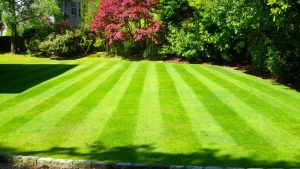Lawn mowing is one of those garden tasks that many people think they can do themselves. Some get it right and do a wonderful job; others are regularly getting it wrong. Perhaps you’d be surprised to learn how much harm you can do to your lawn by not getting the basics right.
What it is that you need to know before mowing your lawn?
When it comes to lawn mowing there are three main considerations:
✅ Mowing Height
✅ Direction of cut
✅ Mowing Frequency
Let’s look at each of them in turn.
Mowing Height 📏
Finding the perfect mowing height is essential for maintaining both a tidy and healthy lawn. Grass needs enough leaf surface to photosynthesize effectively, producing the nutrients it requires for growth and resilience. 🌱☀️
Plants use the green pigment in their leaves, called chlorophyll, to capture sunlight and turn carbon dioxide and water into food. If you cut the grass too short, you reduce its ability to photosynthesise, which weakens the grass and makes it more prone to disease. In winter, this can lead to thinning and bare patches, inviting weeds and moss to settle and spoil the appearance of your lawn.
Why Mowing Height Matters

Mowing height is the biggest cause of lawn problems
Improper mowing height is one of the leading causes of lawn problems. While it’s tempting to mow your lawn short for that tidy look, doing so suddenly or during unfavourable weather conditions can be damaging. Always reduce the mowing height gradually and ensure the grass has enough nutrition and the right conditions—mild temperatures, adequate moisture, and not too much heat.
💡 Pro Tip: Never cut more than one-third of the grass blade length in a single mow to avoid stressing the grass.
Adjusting Mowing Height Throughout the Year
It’s important to vary your mowing height based on the season and weather conditions.
- Early Spring: Set your mower high, allowing the grass to wake up slowly.
- Late Spring: As growth becomes more vigorous, lower the height for a tighter cut.
- Summer: Raise the height again to help the grass retain moisture and protect the soil from heat and drought stress.
- Autumn: Lower the height again as the lawn benefits from cooler temperatures and more rain.
- Winter: Keep the grass longer to help it withstand the stress of cold weather.
💡 Seasonal mowing guide:
- Early Spring ⬆️ High Cut
- Late Spring ⬇️ Low Cut
- Summer ⬆️ High Cut
- Autumn ⬇️ Low Cut
- Winter ⬆️ High Cut
Direction of cut ✂️

Most of us are creatures of habit, mowing the lawn the same way each time. However, mowing in the same direction repeatedly causes the grass blades to lean and makes it harder to get an even cut. It can also lead to the formation of ruts from the mower wheels.
💡 Switch it up: Mow in different directions each time you cut. For example, mow left to right one week, and up and down or diagonally the next. This promotes upright grass growth, reduces soil compaction, and leads to a more uniform lawn.
Mowing Frequency 🔃
How often should I mow my lawn?

Get mowing right and you’re half way towards a perfect lawn
The frequency of mowing depends on several factors such as grass type, soil, weather, and lawn nutrition. A good rule of thumb is to mow your lawn when it needs it, not based on a fixed schedule.
Let’s face it, life is busy, and it’s easy to miss a mow. However, when grass gets too long, it can be harder to cut without damaging the lawn. If you cut into the stem, it shocks the plant, making it more vulnerable to diseases and die-back.
💡 Stay consistent: Try not to miss mowing sessions. Regular mowing keeps grass healthy, encourages dense growth, and prevents scalping.
Mulch Mowing 🌿
Mulch mowing is a fantastic way to nourish your lawn while saving time and effort. Instead of collecting grass clippings, mulch mowing finely chops the grass and redistributes it back onto the lawn. These clippings decompose quickly, returning valuable nutrients like nitrogen, phosphorus, and potassium to the soil. This helps to naturally fertilise your lawn, improving its health and reducing the need for synthetic fertilisers.
Benefits of Mulch Mowing:
- Reduced waste: No need to collect and dispose of grass clippings.
- Nutrient recycling: Clippings decompose, providing organic matter that feeds the lawn.
- Improved moisture retention: Mulched grass helps retain moisture in the soil, reducing water needs during dry periods.
- Saves time: No more bagging and disposing of clippings, making your mowing routine faster and easier.
💡 Mulch mowing tip: Use a specialised mulching mower or attachment to ensure clippings are finely chopped for best results.

 Established 2016
Established 2016



